Thuban, also designated as Alpha Draconis, is a double star system located in the constellation of Draco. Thuban is historically significant since it was the north pole star from the 4th to 2nd millennium BCE.
Key Facts & Summary
- Thuban is a relatively inconspicuous star in the night sky of the Northern Hemisphere, located at around 305 light-years away from the Sun.
- Though it bears the designation Alpha, its apparent magnitude is 3.65, which is 3.7 times fainter than the brightest star in the constellation, Gamma Draconis (Eltanin), whose apparent magnitude is 2.24.
- Thuban has an absolute magnitude of -1.20.
- The Thuban star system has a radial velocity of -13.0 km / -8.0 mi per second.
- Thuban is a single-lined spectroscopic binary, only the primary star can be detected in the spectrum.
- Sometimes, the two stars create eclipses that place Thuban into the class of binaries known as eclipsing binaries.
- Thuban is a white giant star of spectral class A0III, indicating similarities to Vega in temperature and spectrum, but more luminous and massive.
- Thuban has been used as an MK spectral standard for the A0III type. It has ceased hydrogen fusion in its core.
- Thuban has around 2.8 solar masses and 3.4 solar radii.
- It is around 479 times more luminous than our Sun.
- The surface gravity on Tuban has been estimated to be at around 3.5 cgs.
- Thuban has an average surface temperature of around 10,100 K.
- The secondary star has around 2.6 solar masses, and it is around 40 times more luminous than our Sun.
- The binary star pair orbit one another within 51.5 days and an eccentricity of 0.43.
- The two stars are separated from one another by around 0.46 AU
- The eclipses occurring in the Thuban star system lasts for six hours.
Thuban / Alpha Draconis is named after the Dragon’s tail since this is its position in the constellation of Draco, it bore the name Adib. The name is of Arabic origin and it denotes a giant snake.
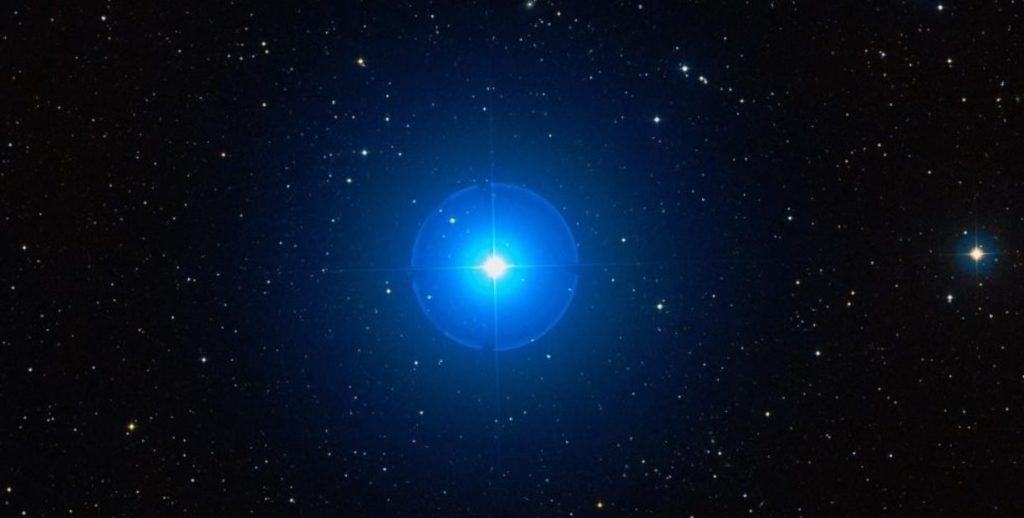
This name was approved by the IAU in 2016. Though it bears the designation Alpha, Thuban is not the brightest star in its constellation. Designations don’t always denote a star’s position, in terms of brightness.
Formation
Thuban formed from an interstellar medium of dust and gas. Gravity pulled the swirling dust and gas together and formed the now dethroned pole star.
Based upon it metallicity, the interstellar medium from which Thuban formed, was somewhat metal-poor. Thuban’s exact age is uncertain. However, it has ceased hydrogen fusion in its core, and it is no longer in the main-sequence.
Distance, Size, and Mass
Thuban is located at around 303 light-years / 93 parsecs away from the Sun. The primary component star is both more massive and several times bigger than our Sun.
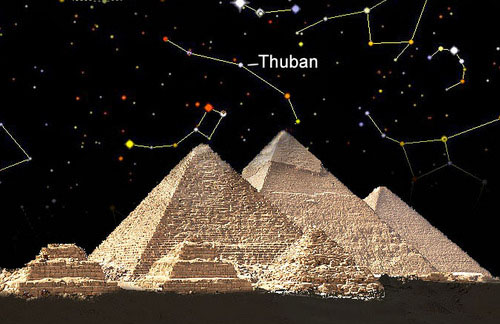
Thuban has 2.8 solar masses, or 280% of the Sun’s mass, and a radius of 3.4 solar radii, or 340% of the Sun’s radius. Based upon its radius, Thuban should be around six times, or more, bigger than our Sun. Thuban’s companion star has 2.6 solar masses or 260% of our Sun’s mass.
Other Characteristics
Thuban is a white giant star of spectral class A0III, indicating similarities to Vega in temperature and spectrum, but more luminous and massive.
Thuban has been used as an MK spectral standard for the A0III type. It has ceased hydrogen fusion in its core and started to expand. It has an apparent magnitude of 3.6 and an absolute magnitude of -1.20.
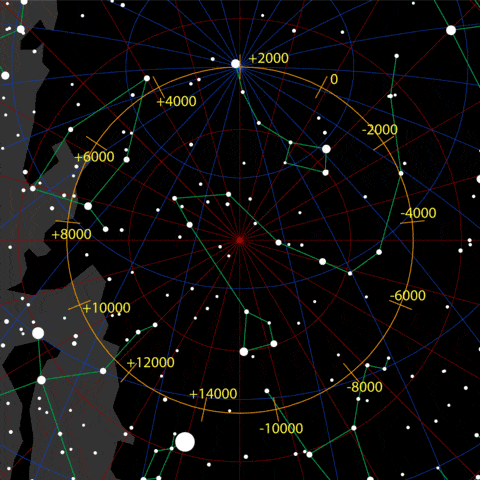
Thuban is 479 times brighter than our Sun and has average surface temperatures of around 10,100 K, or 1.7 times hotter than our Sun.
Thuban’s companion, Alpha Draconis B, is 40 times brighter than our Sun, being 1.83 magnitudes fainter than the primary star. Not much is known about the companion, though it is speculated that it is a main-sequence star slightly cooler than Thuban, and possibly of spectral type A2.
Stellar System
The Thuban / Alpha Draconis star system is a single-lined spectroscopic binary star system, which means that only the spectral liens of the primary component are visible.
The two stars orbit each other once every 51.5 days and have an orbital eccentricity of 0.43. The two components are separated from one another by about 0.46 AU.
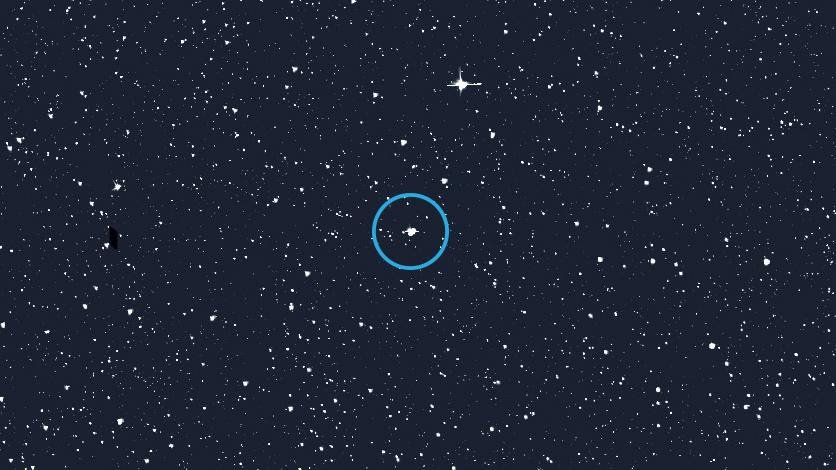
This system is an eclipsing binary star system. The eclipses displayed are only partial, with an inclination of slightly less than 90 degrees, with depths of 9% and 2%. These eclipses last for only six hours.
Polar Star
Thuban is one of the stars that take turns as the North Star during the Earth’s precession cycle. Thuban was the Pole Star from 3942 BCE to 1793 BCE, during the creation of some of Egypt’s largest pyramids.
Thuban was closest to the pole in 2830 BCE, coming closest to the north celestial pole out of all the other pole stars. However, Thuban was among the faintest pole stars.

In comparison, the current pole star, Polaris, comes within 0.5 degrees of the north celestial pole and has an apparent magnitude of 1.98.
As the North Star, Thuban was preceded by Edasich (Iota Draconis) and succeeded by the brighter Kochab (Beta Ursae Minoris), one of the stars of the Little Dipper, and the fainter Kappa Draconis. Thuban has slowly drifted away from true north over the last 4,800 years.
Location
Thuban is located in the constellation of Draco, the eighth largest constellation in the sky and the fourth largest northern constellation, occupying an area of 1,083 square degrees.
Thuban is easy to spot though, from light-polluted areas, this can become a challenge. Thuban lies about halfway between Mizar, the middle star of the Big Dipper’s handle, and Kochab and Pherkad, the stars that form the outer side of the Little Dipper’s Bowl.
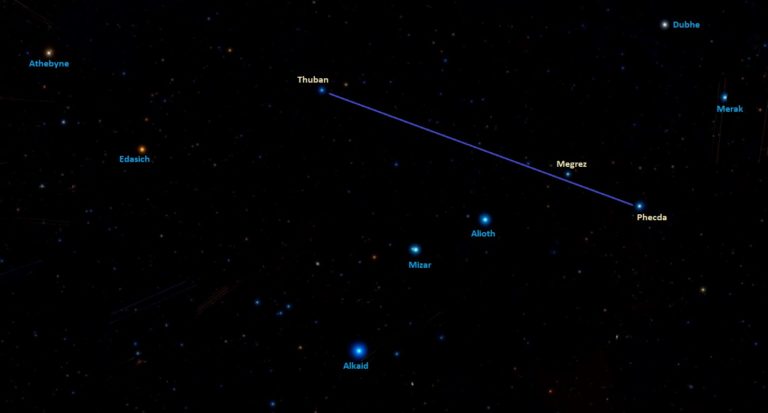
An imaginary line extended from Phecda through Megrez, the inner stars of the Big Dipper’s bowl, points towards Thuban. The constellation of Draco never sets, and is visible throughout the year, for observers in northern latitudes.
Draco contains many interesting deep sky objects such as the lenticular galaxy NGC 5866, the disrupted spiral galaxy Tadpole, the Cat’s Eye Nebula, the massive galaxy cluster Abell 2218, and the Draco Dwarf Galaxy, one of the faintest satellites of the Milky Way.
The best time to observe Thuban, and all the other stars and interesting deep-sky objects in the constellation of Draco, is during the month of July.
The Future
Thuban will continue to survive for many more millions of years, suffering certain changes, for example, it might become a blue giant. Thuban will become once again the North Star in 20346 CE.
Did you know?
- The Chinese know Alpha Draconis / Thuban, as the First Star of Right Wall of Purple Forbidden Enclosure – The Right Wall of Purple Forbidden Enclosure is an asterism formed by Thuban, Kappa Draconis, Giusar, 24 Ursae Majoris, Alpha Camelopardalis, 43 Camelopardalis, and BK Camelopardalis.
- The Right Wall of Purple Forbidden Enclosure asterism is located in the area of the sky around the north celestial pole and it represents the imperial palace. Thuban represents the Right Pivot – You Shu.
Sources:
Image sources:
- https://www.star-facts.com/wp-content/uploads/2020/04/Thuban-1225x620.jpg?189db0&189db0
- https://www.crystalinks.com/Thuban-GizaPyramids.jpg
- https://upload.wikimedia.org/wikipedia/commons/thumb/1/16/Precession_N.gif/480px-Precession_N.gif
- https://cdn.mos.cms.futurecdn.net/9WutevV4JL7VaD4i8pHY9g.jpg
- https://www.star-facts.com/wp-content/uploads/2019/09/North-Stars.jpg
- https://www.star-facts.com/wp-content/uploads/2020/04/Thuban-location-768x413.jpg
